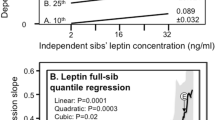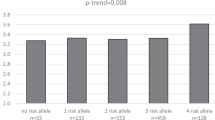Abstract
OBJECTIVE: To investigate linkage and association between the leptin receptor (LEPR) gene and body composition variables in the Québec Family Study (QFS).
DESIGN: Single-point linkage analysis using families, and covariance and chi-square analyses using normal weight and obese unrelated subjects from QFS.
SUBJECTS: 169 nuclear families were used for linkage study. 308 unrelated subjects (146 males; 162 females) from these families were used for chi-square testing of genotype and allele distributions between subjects with body mass index (BMI) <27 kg/m2 (n=167) and those with BMI≥27 kg/m2 (n=141), and for a series of covariance analyses using age, plus height for fat mass (FM) and fat free mass (FFM), as covariates. A corrected P value (P*) for multiple tests has been calculated according to P*=1-(1-P)number of phenotypes.
MEASUREMENTS: Variables were BMI (in kg/m2), sum of six skinfolds (SF6 in mm), FM (in kg), percent body fat (%FAT) and FFM (in kg). Polymerase chain react restricted fragment length polymorphisms PCR-RFLP) was used to identified a K109R substitution in exon 4, a Q223R in exon 6, a K656N in exon 14 and an automatic DNA sequencer for a CA microsatellite repeat in intron 3, and heteroduplex pattern on non-denaturing gel for a CTTT repeat in intron 16.
RESULTS: Good evidence of linkage was observed for Q223R with FM (P=0.005; P*=0.02), and for the CTTT repeat with FFM (P=0.007; P*=0.03). Weaker linkages (0.02≤P≤0.05) were also observed between Q223R and BMI, SF6 and FFM, between the CA repeat and BMI, SF6 and FM, and between the CTTT repeat and FM. Moreover, FFM values were found to be different among genotypes for the CTTT repeat polymorphism with heavier females, carriers of the 123* allele at the CTTT repeat, showing 4 kg less of FFM (43.6±1.0, n=21 vs 47.7±0.8, n=30; P=0.005; P*=0.02) than non-carriers. Also, at the Q223R polymorphism, in lower BMI males, carriers of the Q223 allele were 4 kg lighter in FFM (53.4±0.6, n=47 vs 56.6±0.9, n=18; P=0.005; P*=0.02) than non-carriers. No significant differences were observed between lower and higher BMI subjects in genotype and allele frequency distributions for any of the polymorphisms.
CONCLUSIONS: These results indicate that the LEPR gene is involved in the regulation of the body composition in human particularly of FFM in the QFS.
This is a preview of subscription content, access via your institution
Access options
Subscribe to this journal
Receive 12 print issues and online access
$259.00 per year
only $21.58 per issue
Buy this article
- Purchase on Springer Link
- Instant access to full article PDF
Prices may be subject to local taxes which are calculated during checkout
Similar content being viewed by others
Author information
Authors and Affiliations
Rights and permissions
About this article
Cite this article
Chagnon, Y., Chung, W., Pérusse, L. et al. Linkages and associations between the leptin receptor (LEPR) gene and human body composition in the Québec Family Study. Int J Obes 23, 278–286 (1999). https://doi.org/10.1038/sj.ijo.0800809
Received:
Revised:
Accepted:
Published:
Issue Date:
DOI: https://doi.org/10.1038/sj.ijo.0800809
Keywords
This article is cited by
-
Genome-wide analyses reveal a strong association between LEPR gene variants and body fat reserves in ewes
BMC Genomics (2022)
-
Association between LEPR, FTO, MC4R, and PPARG-2 polymorphisms with obesity traits and metabolic phenotypes in school-aged children
Endocrine (2018)
-
The association of insertions/deletions (INDELs) and variable number tandem repeats (VNTRs) with obesity and its related traits and complications
Journal of Physiological Anthropology (2017)
-
Leptin and leptin receptor gene polymorphisms and their association with plasma leptin levels and obesity in a multi-ethnic Malaysian suburban population
Journal of Physiological Anthropology (2014)
-
Novel locus for fibrinogen in 3′ region of LEPR gene in island population of Vis (Croatia)
Journal of Human Genetics (2014)



